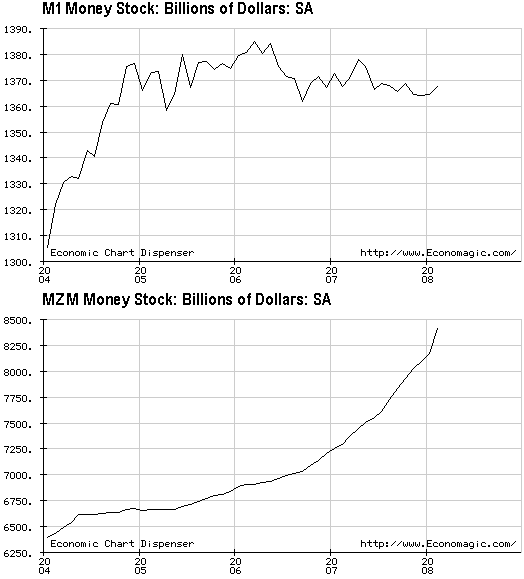|
|||
Is the Fed deflating?Steve Saville
Several subscribers have asked us to comment on Gary North's article at http://www.garynorth.com/public/3118.cfm. In this article Mr. North claims that the Fed is deflating (contracting the money supply), a claim that rests solely on the lack of growth (or outright decline) in the monetary base. Considering the extraordinary measures* taken by the Fed over the past four months in order to inflate (grow the money supply), the idea that the Fed is purposefully deflating (contracting the money supply) is preposterous. So, what should we make of the small decline in the monetary base? Not much, actually, because regulatory changes made during the 1990s made it possible for banks to substantially reduce the amount of money held in the form of reserves at the Fed by automatically "sweeping" money from the types of accounts that have reserve requirements to the types of accounts that do not have reserve requirements**. These regulatory changes effectively severed the link between the monetary base and the total supply of money. In other words, changes in the money supply are no longer governed by changes in the monetary base. A related point worth mentioning is that the changes routinely made by the Fed to the monetary base are constrained by the difference between the effective Fed Funds rate (FFR) and the target FFR. To be specific, if the Fed wants to keep the effective FFR near its target then it can only increase the monetary base when the effective rate is above the target rate. Over the past several months, however, the actual overnight interest rate (the effective FFR) has almost always been below the Fed's target. This means that the Fed has been tagging along behind the market, which is, by the way, invariably the case around major interest-rate turning points. To summarise the above, changes in the monetary base usually have very little to do with changes in the total supply of money (inflation/deflation). Furthermore, we can observe that the Fed has been taking 'heroic' measures in an effort to keep the inflation going. Therefore, there is no evidence that the Fed is TRYING to deflate (quite the opposite, actually); but is it the case that deflation is occurring DESPITE the Fed's best efforts? No, that is definitely not the case. As evidenced by the following charts, M1 -- a very narrow measure of money supply that tends to move in synch with the monetary base -- has essentially gone nowhere over the past three years, while MZM, a more comprehensive measure of liquid money supply within the economy, has experienced a parabolic increase. For some reason unknown to us, Mr. North is fixating on ultra-narrow monetary aggregates such as M1 while ignoring the broader, and more useful, measures of money supply.  There is certainly a chance that the inflation rate (the rate of increase in the BROAD money supply) will slow over the coming months, but if/when that happens it will be a market-driven, not a Fed-driven, occurrence. Moreover, the Fed can be relied upon to fight any substantial slowdown in the inflation rate and to ultimately win such a fight. There are a lot of things the Fed cannot do, but the one thing it can always do is increase the supply of money. *A little over three months ago the Fed introduced the Term Auction Facility (TAF) to make it easier and less costly for banks to obtain money. When that proved to be insufficient, the Fed introduced the Term Securities Lending Facility (TSLF) in an effort to inject more "liquidity" into the banking system. And when the TAF combined with the TSLF failed to give the desired inflationary boost, the Fed offered to lend huge amounts of money to non-bank financial corporations. **From the 5th March 2007 Weekly Update: "Many pundits still treat M1's growth rate as an important indicator of monetary conditions on the basis that the amount of 'narrow money' is supposed to have a substantial influence on the total supply of money due to the famous "money multiplier" effect. In fact, some well-respected analysts have expressed concern that the lack of growth in the narrowest measures of US money supply over the past couple of years means that Fed policy has been excessively restrictive. But these analysts are failing to appreciate that regulatory changes made by the Fed in the early 1990s caused M1 to become a shadow of its former self with respect to its usefulness as a general monetary indicator. In rough terms, the rules were changed in the early 1990s to allow banks to dramatically reduce the amount of money held in the form of reserves at the Fed by "sweeping" money from checking accounts (components of M1 that are subject to reserve requirements) into savings accounts (non-M1 components of M2 for which there are no reserve requirements). For example, you might think you have a checkable deposit at your local bank, but in the bank's books you probably have a zero-interest CD (the type of deposit that has no reserve requirement). Whenever one of your checks is presented the bank's software "sweeps" the relevant amount of money from the zero-interest CD you never knew you had into the checking account you thought you had. These rule changes have made commercial banks more profitable because money held in reserve at the Fed is money that doesn't generate income for the banks; and this, of course, is why the changes were made in the first place." Steve Saville Regular financial market forecasts and analyses are provided at our web site: We aren't offering a free trial subscription at this time, but free samples of our work (excerpts from our regular commentaries) can be viewed at: http://tsi-blog.com Saville Archives |
